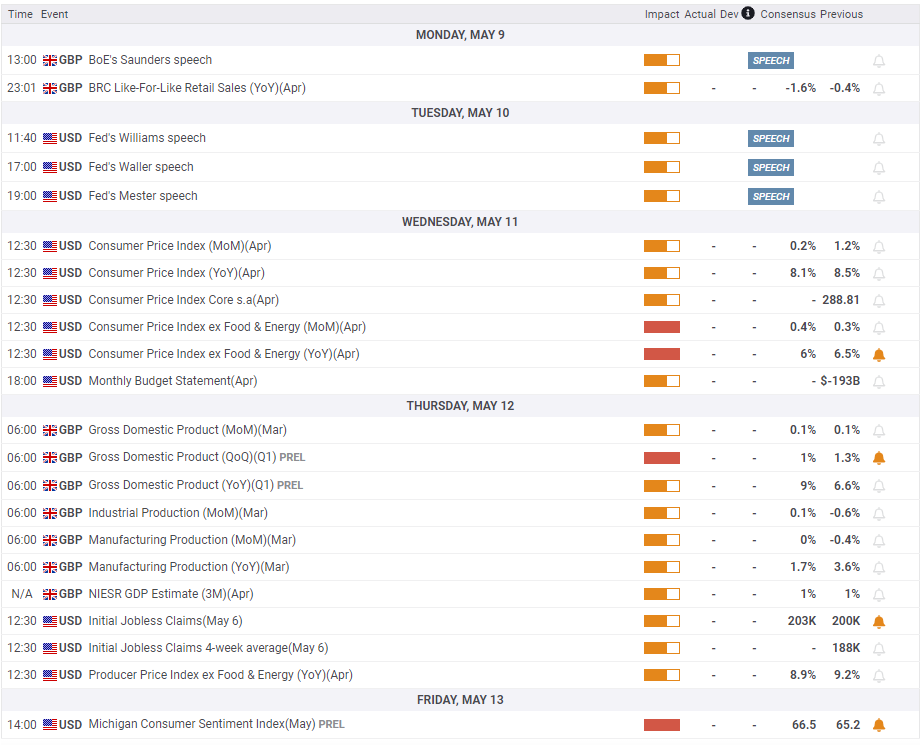- GBP/USD witnessed a fresh downside leg during Fed/BOE week.
- Cableslumped to 22-month lows as the BOE fanned UK recession fears.
- A bear flag on the daily chart points to more pain, with eyes on US inflation, UK GDP.
The Fed-BOE contrast remained in play, despite the less aggressive Fed stance, as the dire UK economic outlook widened the economic divergence alongside the monetary. GBP/USD was fairly resilient throughout the week before crashing to fresh 22-month lows below the 1.2300 mark. The pair has recorded the third straight weekly loss, as attention turns towards the US inflation and the UK quarterly GDP.
GBP/USD: Nothing stopped bears
After the previous week’s selling spiral to 1.2411, the lowest level since July 2020, GBP/USD entered a phase of downside consolidation in the first half of the week. The early May bank holiday in the UK and risk-averse market conditions prompted the US dollar bulls to take control. Contraction in the Chinese business activity due to the ongoing covid lockdowns in the country dented the market mood.
GBP bulls, however, managed to find some comfort from pre-Fed meeting dollar repositioning, while the greenback pulled back on disappointing US ISM and S&P Global Manufacturing PMIs. Cable buyers bought into the dip below 1.2500, as risk sentiment improved and weighed negatively on the safe-haven buck. Meanwhile, the pound cheered the Reuters report that markets now price in a 30% probability of a larger than expected, 50 bps hike from the BOE on Thursday, especially after Tuesday’s Reserve Bank of Australia's (RBA) 25 bps hawkish hike.
The GBP/USD rebound only strengthened after the dollar correction gathered steam alongside a fall in the US Treasury yields following the Fed’s less aggressive tightening stance on Wednesday. The world’s most powerful central bank turned out to be less hawkish than expected, pouring cold water on expectations of a 75 bps rate lift-off in June. The Fed decided to hike the key Fed Funds rate by the expected 0.50% while commencing the balance sheet reduction process at a rate of $47.5 billion per month from June 1st with an intention to raise it to $95 billion in three months.
The currency pair failed to resist bearish pressure once again above 1.2600 and witnessed a massive sell-off on Thursday, as the BOE projected a recession for the UK economy in the final quarter of 2022 after unanimously hiking the key rates by 25 bps to 1%. The ‘Old Lady’ raised inflation forecasts, citing that inflation is peaking at around 10% in the Q3 vs. the previous 7.5% in April. Global growth fears intensified, which triggered a fresh flight to safety mode and revived the dollar’s haven demand. Cable hit 22-month lows at 1.2325, shedding 300 pips on ‘Super Thursday’.
There was no reprieve for cable on Friday, as it renewed 22-month lows below 1.2300 during the European trading hours. The dollar preserved its strength ahead of the weekend as the US jobs report confirmed tight labor market conditions and didn't allow the pair to stage a meaningful rebound. The US Bureau of Labor Statistics reported that Nonfarm Payrolls rose by 428,000 in April, surpassing the market expectation of 391,000. Additionally, the Labor Force Participation Rate edged lower to 62.2% from 62.4% in March and the annual wage inflation stayed little changed at 5.5%.
Week ahead: US Inflation and UK GDP take center stage
Following a dramatic week, dominated by central bank events, markets now brace for the US inflation and UK GDP releases, which will stand out in an otherwise relatively light week. Meanwhile, cable will continue dancing to the dynamics of the dollar and the Fed-BOE divergence.
The week starts with the speech by the BOE policy-maker Micheal Saunders on Monday. Note that Saunders joined other hawks Catherine Mann and Jonathan Haskel to vote for a 50 bps hike at the BOE policy meeting last Thursday.
Tuesday is data-empty, as it offers no first-tier economic releases from both sides of the Atlantic –although Fedspeak could gather attention.
The all-important US Consumer Price Index (CPI) for April drops in on Wednesday, which could offer fresh hints on the Fed’s policy guidance.
On Thursday, the UK Q1 Preliminary GDP data will be published alongside the monthly figure and the Manufacturing Production data. This could have a significant impact on the pound, given the BOE’s warning of stagflation. Later in the day, the US will publish the Producer Price Index (PPI) for April.
Friday will be relatively quiet, with the only US Preliminary Michigan Consumer Sentiment due on the cards. Fed policymaker Loretta Mester will also make an appearance.
GBP/USD: Technical outlook
The bear flag formation seen on the daily chart suggests that the pair is likely to target new lows in the near term. The flag pole covers approximately 500 pips, suggesting that the next bearish target aligns at around 1.2100, taking 1.2600 as the starting point of the current downtrend.
It's worth noting, however, that the Relative Strength Index (RSI) indicator on the same chart stays below 30, pointing to oversold conditions. In case the pair stages a correction, 1.2400 (psychological level, bottom of the bear flag pole) aligns as the first resistance before 1.2500 (psychological level).
On the downside, 1.2200 (psychological level) and 1.2170 (static level from May 2020) could act as interim supports ahead of 1.2100.
GBP/USD: Sentiment poll
The FXStreet Forecast Poll shows that the majority of polled experts see the pair pushing lower next week. The one-month and the one-quarter outlooks, however, remain overwhelmingly bullish.
Information on these pages contains forward-looking statements that involve risks and uncertainties. Markets and instruments profiled on this page are for informational purposes only and should not in any way come across as a recommendation to buy or sell in these assets. You should do your own thorough research before making any investment decisions. FXStreet does not in any way guarantee that this information is free from mistakes, errors, or material misstatements. It also does not guarantee that this information is of a timely nature. Investing in Open Markets involves a great deal of risk, including the loss of all or a portion of your investment, as well as emotional distress. All risks, losses and costs associated with investing, including total loss of principal, are your responsibility. The views and opinions expressed in this article are those of the authors and do not necessarily reflect the official policy or position of FXStreet nor its advertisers. The author will not be held responsible for information that is found at the end of links posted on this page.
If not otherwise explicitly mentioned in the body of the article, at the time of writing, the author has no position in any stock mentioned in this article and no business relationship with any company mentioned. The author has not received compensation for writing this article, other than from FXStreet.
FXStreet and the author do not provide personalized recommendations. The author makes no representations as to the accuracy, completeness, or suitability of this information. FXStreet and the author will not be liable for any errors, omissions or any losses, injuries or damages arising from this information and its display or use. Errors and omissions excepted.
The author and FXStreet are not registered investment advisors and nothing in this article is intended to be investment advice.
Recommended Content
Editors’ Picks

Gold rallies to new record-high above $3,030
Gold benefits from escalating geopolitical tensions and extends its rally to a new record-high above $3,030 in the American session on Tuesday. Israel resumed military operations against Hamas in Gaza after the group rejected US proposals for extending ceasefire. All eyes now remain on the Trump-Putin call.

EUR/USD retreats from fresh 2025 highs, flirts with 1.0900
EUR/USD retreats from the multi-month high set above 1.0950 earlier in the day and tests 1.0900. The risk-averse market atmosphere helps the US Dollar (USD) holds its ground and makes it difficult for the pair to preserve its bullish momentum.

GBP/USD turns south after testing 1.3000
After reaching its highest level since early November above 1.3000, GBP/USD loses its traction and declines toward 1.2950 on Tuesday. The US Dollar makes a strong comeback and weighs on the pair, helped by upbeat local data and the souring risk mood ahead of this week's key central bank meetings.

Trump-Putin talks raise hopes of a ceasefire – Middle East risk returns
The prospective end to the Russia-Ukraine war has traders excited for a more positive growth outlook in Europe going forward, with heavily industrialised nations such as Germany having suffered under the weight of elevated energy costs in recent years.

Tariff wars are stories that usually end badly
In a 1933 article on national self-sufficiency1, British economist John Maynard Keynes advised “those who seek to disembarrass a country from its entanglements” to be “very slow and wary” and illustrated his point with the following image: “It should not be a matter of tearing up roots but of slowly training a plant to grow in a different direction”.

The Best brokers to trade EUR/USD
SPONSORED Discover the top brokers for trading EUR/USD in 2025. Our list features brokers with competitive spreads, fast execution, and powerful platforms. Whether you're a beginner or an expert, find the right partner to navigate the dynamic Forex market.


